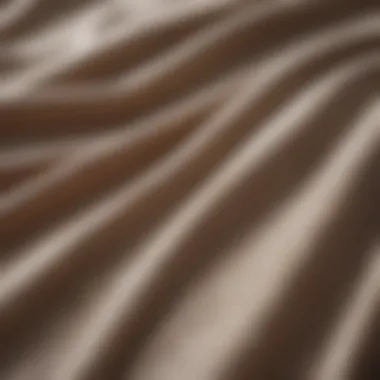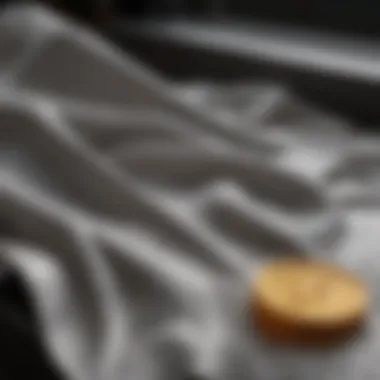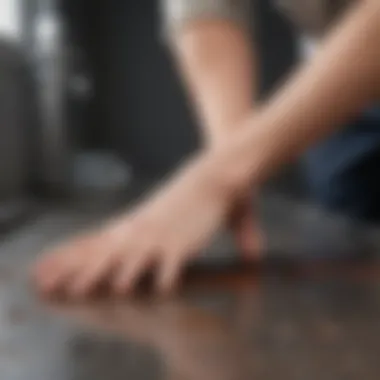Effective Techniques to Remove Grease Stains Easily


Intro
Grease stains on clothes can be a troublesome experience. They often appear when least expected – during meals, while cooking, or even while attending a busy gathering. The frustration of seeing that oily mark on a favorite shirt or dress can be quite overwhelming. However, the good news is that there are effective methods for removing grease stains without resorting to traditional washing. This article aims to uncover these techniques, offering practical tips for addressing stubborn stains in a more approachable manner.
In this exploration, we will discuss a variety of household items that can be used to combat grease, specific tools designed for stain removal, and immediate stain management strategies. These methods are accessible and practical, catering to a wide range of readers from busy homeowners to meticulous party hosts. Understanding and applying these techniques can save time and maintain the integrity of precious garments.
Techniques for Immediate Stain Management
Addressing a grease stain promptly can significantly influence the outcome of the removal process. Here are some critical steps to consider:
- Act Quickly: The sooner you treat the stain, the more likely you are to remove it completely.
- Blot, Don’t Rub: Use a clean cloth or paper towel to blot the stain gently. Rubbing can push the grease deeper into the fabric.
- Use Absorbent Materials: Talcum powder, cornstarch, or baking soda can be sprinkled on the stain. These substances help absorb the oil before it sets, making it easier to treat later.
Household Items Useful for Grease Removal
Many common household items can also effectively tackle grease stains. Here are some noteworthy options:
- Dish Soap: A few drops of dish soap mixed with water can create a powerful cleaning solution. Apply it to the stain, let it sit for a few minutes, and then blot.
- Vinegar: White vinegar acts as a natural degreaser. Apply it directly to the stain and let it work its magic for about 10 to 15 minutes.
- Baby Powder: Similar to baking soda, baby powder can absorb oil efficiently. Apply it and let it sit before brushing away the excess.
- Hand Sanitizer: The alcohol in hand sanitizer may help cut through grease. Apply a small amount directly to the stain, let it sit for several minutes, then blot it away.
Final Thoughts
Equipping yourself with knowledge about grease stain removal can preserve your clothing and save you the discomfort of finding alternative wardrobe choices. By implementing the techniques discussed in this article, you not only enhance your ability to manage stains but also extend the life of your garments. Strategies range from utilizing everyday household items to understanding the significance of prompt action.
"The key to effective grease stain removal lies in immediate action and the right household tools."
While you may encounter various products claiming to eliminate such stains, knowing how to use simple materials you already have at home can often yield superior results. The next time you face a grease stain, remember these strategies and reclaim your clothes effectively.
Understanding Grease Stains
Grease stains can pose significant challenges when it comes to clothing maintenance. Understanding these stains is crucial for effective removal. They may originate from various sources, including cooking oils, automotive grease, and even lotions. Each source carries different characteristics, making the approach to removal somewhat specific. The quicker one addresses the stain, the easier it becomes to eliminate it.
Benefits of Understanding Grease Stains:
- Timing: Knowledge of how grease stains form helps in prompt action, significantly increasing chances of successful removal.
- Material-Specific Techniques: Different fabrics react differently to grease. Recognizing this aids in selecting appropriate removal methods.
- Preventive Measures: By understanding grease characteristics, one can adopt strategies to prevent stains from settling into the fibers permanently.
The complexity of grease stains lies in their oily nature. These stains tend to bind with fibers in fabrics, which is why they can be particularly stubborn without appropriate intervention. The next section delves into the nature of grease stains, clarifying their composition and behavior.
Immediate Actions to Take
Addressing grease stains promptly plays a pivotal role in effectively removing them from clothes. Immediate actions can prevent stains from setting in, which makes the cleaning process more efficient. Grease can quickly bind to fabric fibers, making it more challenging to remove later. By acting fast, you can greatly reduce the chances of permanent staining.
Blotting the Stain
Recommended Materials for Blotting
When dealing with grease stains, selecting the right materials for blotting is essential. Recommended materials include paper towels, clean cloths, or even coffee filters. Paper towels are absorbent and disposable, making them a convenient option. They effectively absorb excess grease without pushing the stain deeper into the fabric. Clean cloths can be reused, but it's essential to ensure they are free of dyes or fragrances to avoid further staining. The choice of material impacts how much grease is removed during the blotting process, hence selecting high-quality, absorbent materials is vital for success.


- Key Characteristic: Absorbency is crucial.
- Unique Feature: Ease of disposal with paper towels makes them advantageous.
- Advantages: They help lift grease without smearing.
- Disadvantages: Some cloths may leave lint behind.
Step-by-Step Blotting Process
Effective blotting can significantly aid in stain removal. This process consists of a few simple steps that can maximize grease removal. First, gently place your chosen material over the stain, allowing it to absorb the grease without rubbing. Once you lift the blotting material, replace it as needed until no more grease transfers.
- Key Characteristic: Gentle approach prevents spreading.
- Unique Feature: Immediate lift-off method reduces grease penetration.
- Advantages: It ensures that the fabric is not damaged during the process.
- Disadvantages: Requires patience as it may take several attempts to achieve optimal results.
Scraping Off Excess Grease
Before blotting the stain, it's often helpful to remove as much excess grease as possible. Using a dull knife or a credit card, gently scrape the outer edge of the grease stain, working inward. This technique minimizes the tendency of the grease to smudge or spread, making it easier to tackle the remaining stain with blotting methods afterward.
A few precautions are essential when scraping:
- Make sure not to press too hard, as this can damage the fabric.
- Always scrape in one direction to avoid pushing the grease deeper.
Following these immediate actions can significantly improve your chances of successfully removing grease stains from your clothing without the need for washing. With the right materials and techniques, you can give your clothes a better chance to remain in pristine condition.
Household Items for Grease Removal
Understanding how to remove grease stains without washing involves more than just knowing a few tricks. Household items are often the first line of defense in tackling these stains. They can be easily found and utilized effectively. Using common products minimizes the need for harsh chemicals, making the process safer for both the fabric and the environment.
Daily items are not only cost-effective but also accessible. This section explores how certain items like baking soda, cornstarch, and dish soap play a crucial role in grease removal. Each has its unique properties that aid in lifting grease stains, allowing for immediate surface treatment without the need for full washing.
Baking Soda as an Absorbent
Baking soda is a versatile compound known for its absorbent properties. Its effectiveness in absorbing oils makes it a popular choice for treating grease stains on clothing. The fine particles penetrate the stain, drawing out the grease, and is a simple yet powerful tool in the stain removal process.
Application Method
To apply baking soda, start by sprinkling it generously over the grease stain. Gently rub it into the fabric using your fingers or a soft brush. This gentle abrasion helps the soda to work effectively into the stain. After letting it sit for at least 30 minutes, brush off the excess powder.
This method is beneficial because it is straightforward and safe for most fabrics. Baking soda is non-toxic and does not have a strong odor, making it ideal for many household cleaning tasks. However, it may require several applications for older or more stubborn stains.
Effectiveness and Limitations
While baking soda is effective in many cases, it does have limitations. It works best on fresh stains rather than those that have set. It may not completely remove all types of grease, especially if the material is delicate or the stain is more extensive than anticipated. Despite these limitations, its low cost and ease of use have made it a reliable option in household stain removal routines.
Cornstarch and Its Uses
Cornstarch is another common kitchen item that serves well for removing grease from clothes. Much like baking soda, it absorbs oil but has a different texture that makes it suitable for certain types of stains.
How to Apply Cornstarch
Applying cornstarch is straightforward. Sprinkle a generous amount directly over the grease stain. Let it sit for about 15 to 20 minutes, allowing the cornstarch to absorb the grease. Afterward, carefully brush it away. If needed, repeat the process until the stain lightens considerably.
This is a beneficial choice because cornstarch is especially effective on greasy stains from food products. It is non-abrasive, making it suitable for delicate fabrics as well. However, as with baking soda, it may not be effective for all greasy substances or set-in stains.


Proper Removal Techniques
For optimal results when using cornstarch, ensure to brush it away properly after it has absorbed the grease. Sometimes, a vacuum can be used for removal to ensure all particles are gone. This unique feature of cornstarch lies in how it does not leave any residue, which can happen with some powders. However, it does not work as effectively on stains that have been laundered previously.
Dish Soap and its Application
Dish soap is often underestimated in the context of clothing stain removal. Its formulation is designed to tackle grease on dishes, making it inherently effective on grease stains in garments as well.
Choosing the Right Dish Soap
Look for dish soaps that are free from added fragrances or dyes for use on your clothes. Brands like Dawn or Palmolive have been noted for their effective grease-cutting capabilities. Using a well-formulated dish soap allows for a combination of grease removal and gentle cleaning without damaging the fabric.
How to Use Dish Soap on Set Stains
To use dish soap, apply a few drops directly onto the stain and gently rub it with your finger or a soft cloth. Let it sit for at least 10 minutes before blotting with a clean, damp cloth. This process allows the soap to cut through the grease without needing to wash the entire garment. However, care must be taken to ensure you do not over-soak the fabric, as too much water can spread the stain.
In summary, these household items provide practical, cost-effective methods for removing grease stains without the need to wash clothes. By understanding their application and effectiveness, one can manage stains efficiently, prolonging the life of garments and reducing reliance on commercial products.
Commercial Products for Grease Stain Treatment
In the quest to effectively remove grease stains from clothing, commercial products play a significant role. Unlike home remedies, these specialized products are designed with active ingredients that target grease specifically. Utilizing such products often leads to quicker results and can be more effective for stubborn stains. Knowing which products are available can save both time and frustration.
Stain Remover Sprays
Suggested Brands
Among various options, brands like OxiClean, Spot Shot, and Shout have gained a reputation for their efficacy. OxiClean features a unique formula that works on multiple types of stains, including grease. Its versatility makes it a favored choice. Spot Shot is appreciated for its rapid action on oil-based stains, leading to less waiting time for users. Meanwhile, Shout stands out because of its easy application and compatibility with various fabrics. The notable characteristic of these brands is their targeted formulations that tackle grease without damaging clothing fibers, making them a reliable choice for many.
Application Guidelines
Proper application is vital for achieving the best results with stain remover sprays. Users should first identify the fabric type and follow the guidelines specific to the product. Generally, spraying the stained area, allowing it to sit for a few minutes, and then blotting with a clean cloth is recommended. This straightforward approach maximizes the effectiveness of the spray. The main advantage of following such guidelines is the optimization of stain removal potential. However, care must be taken not to oversaturate, as this might lead to excess residue on the fabric.
Grease-Fighting Gels
Grease-fighting gels are another powerful option for stain treatment. These products often have a thicker consistency that allows them to cling to stains more effectively. Their formulation often includes powerful surfactants that help in breaking down tough grease molecules. This is particularly beneficial for set-in stains that may resist lighter treatments.
Spot Removal Wipes
Usage Instructions
Spot removal wipes provide a convenient solution for treating grease stains on the go. Their compact size allows for easy storage in bags or cars, making them accessible whenever needed. To use, simply remove a wipe from the package and gently dab the stained area. The key characteristic here is their portability and instant application, making them an ideal choice when you have no access to laundry facilities. One advantage is their user-friendly nature, as they require no additional tools for application, but they may not be as effective on larger stains compared to sprays or gels.
Effectiveness Overview
While spot removal wipes are practical, their effectiveness can vary based on the specific product and the type of stain. They are generally most effective on fresh stains, as older stains may require additional treatment. The convenience of wipes makes them popular among users seeking immediate solutions, yet it can be important to note that they sometimes require follow-up treatment for deeper stains. This aspect should be considered when relying solely on wipes for grease removal.


Avoiding Damage During Treatment
When addressing grease stains, it is vital to ensure that your treatment methods do not cause further damage to the fabric. Different fabrics react differently to various treatments, and some can be delicate. By understanding the fabric type and applying the right techniques, one can effectively remove grease without compromising the integrity of the material.
Understanding Fabric Types
Fabric types can significantly influence the effectiveness of grease stain removal methods. For instance, cotton and polyester are generally more durable and can withstand harsher treatments, while silk and wool are more sensitive. Knowing these differences helps to tailor your approach effectively. Here are common fabric types:
- Cotton: Strong and can typically endure most stain removal techniques.
- Polyester: Similar to cotton in robustness but may vary in how it responds to heat.
- Silk: Delicate; avoid harsh chemicals and hot treatments.
- Wool: Also delicate; gentle treatment is required to avoid shrinking or damage.
Using the wrong technique on the wrong fabric may lead to discoloration or even tearing. For example, applying baking soda to silk may work on cotton, but it could damage the fibers of silk.
Test Before Full Application
Testing any stain treatment on an inconspicuous area of the fabric is a critical step. This step will help ensure that the treatment does not cause unwanted effects such as fading or discoloration. Here’s how to conduct a proper test:
- Select an Area: Choose a hidden section of the garment, like a hem or inside seam.
- Apply Treatment: Place a small amount of the chosen substance on the fabric.
- Wait and Observe: Allow it to sit for a few minutes. Check for any signs of damage or color change.
- Assess Result: If there are no adverse effects, it is safe to proceed with the treatment for the grease stain.
Remember, what works on one fabric may not work on another. Always err on the side of caution.
By following these guidelines, you can avoid damage during treatment and ensure that your efforts to remove grease stains are effective without harming your clothing.
Long-Term Solutions for Stain Prevention
Long-term solutions for stain prevention are crucial not only in maintaining the aesthetic allure of your clothing but also in reducing the time and effort needed for stain treatment in the long run. Grease stains, in particular, can become a persistent problem if not addressed properly. By implementing preventive measures, you can minimize the chances of permanent stains and save yourself from the hassle of repeated cleaning attempts.
When one opts for proper precautions, it becomes easier to manage everyday accidents caused by food, oil, or other grease sources. Moreover, understanding fabric types and their properties plays a vital role in preventing stains. Just as a house requires a sturdy foundation, your wardrobe benefits from the right materials.
Choosing Stain-Resistant Fabrics
Selecting stain-resistant fabrics can significantly reduce the risk of grease stains from setting in. Fabrics treated with stain-release finishes or those made from synthetic blends often perform better against staining. For instance, polyester and treated cotton tend to repel liquids, making grease removal easier. Fabrics like Teflon-treated textiles provide an added defense against stains.
When purchasing new clothes, consider the following recommendations:
- Look for labels: Seek out items labeled as stain-resistant or water-repellent. This indicates a treatment has been applied to help prevent absorption.
- Choose tighter weaves: Fabrics with tighter weaves are generally less porous, making it harder for grease to penetrate.
- Test fabric durability: Some fabrics can withstand various treatments. A simple test at home with water can indicate how resistant a fabric is before you buy.
Proper Care for Grease-Prone Clothing
Once you have stain-resistant fabrics, proper care is essential to maintain their properties. Regular care routines and specific washing treatments can further enhance their resistance to grease.
- Immediate spot cleaning: Address any spills immediately, even if the fabric is treated. Quick response can save the fabric from becoming permanently stained.
- Washing techniques: Use appropriate detergents specifically formulated for grease removal. Ensure that your washing method matches the fabric type to avoid damage.
- Avoid fabric softeners: While they make clothes feel softer, they can reduce the effectiveness of a stain-resistant treatment over time.
- Follow care instructions: Always adhere to the manufacturer’s care labels to preserve the fabric’s resistance properties.
In summary, understanding stain-resistant fabrics and applying proper care techniques can significantly mitigate the risk of grease stains, ensuring that your clothing stays fresh and presentable. By taking preventive measures, you can enjoy your garments longer and with greater confidence.
The End
Addressing grease stains promptly and effectively is crucial for maintaining the appearance and longevity of clothing. This article has discussed several practical techniques for removing grease stains without the need for a full wash. Understanding different methods equips readers with the tools they need for immediate action, using household items or commercially available products.
By applying these techniques, homeowners can prevent further staining and fabric damage. For instance, substances like baking soda and cornstarch absorb grease effectively, while dish soap breaks it down without harsh impacts on the fabric. Readers should prioritize testing methods on inconspicuous areas first to avoid unwanted results.
In terms of stain prevention, selecting the right fabrics and ensuring proper care play significant roles. Grease-resistant materials can make life easier, especially for those who frequently deal with oily substances in cooking or activities.
Ultimately, having a strategic approach to grease stain removal can save time, resources, and frustration. This knowledge empowers individuals to respond confidently to stains, enhancing both the wearability of their clothes and the efficiency of stain management techniques.



